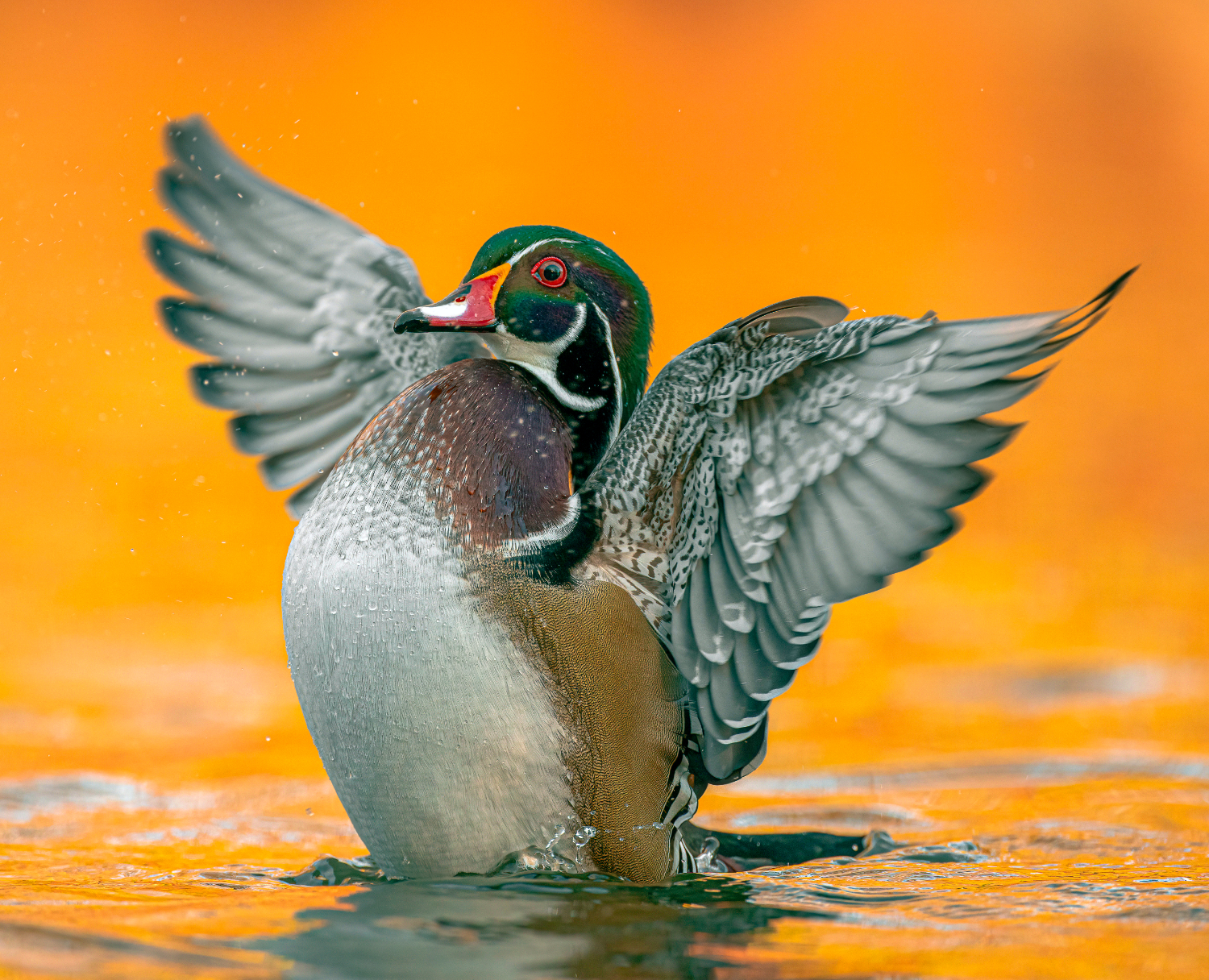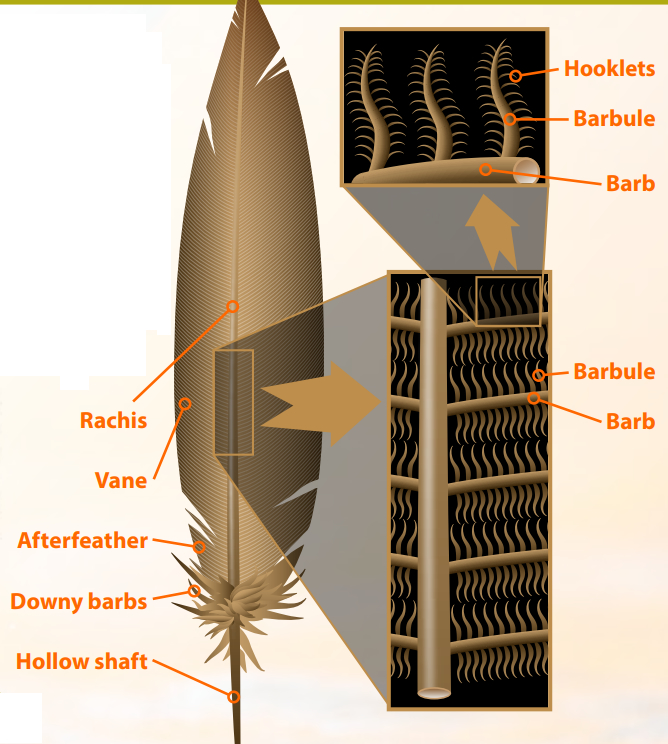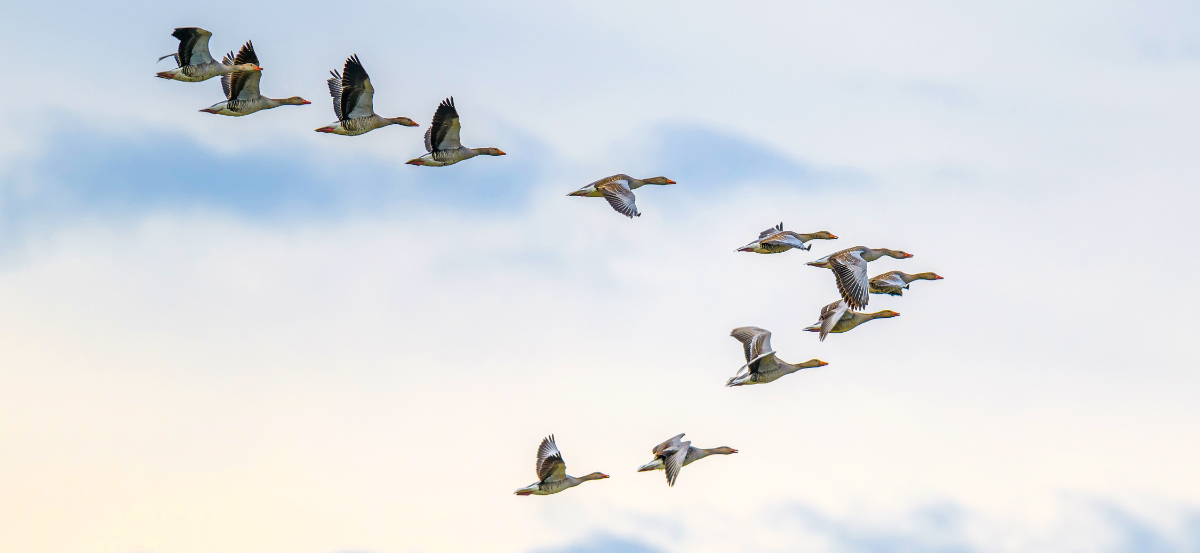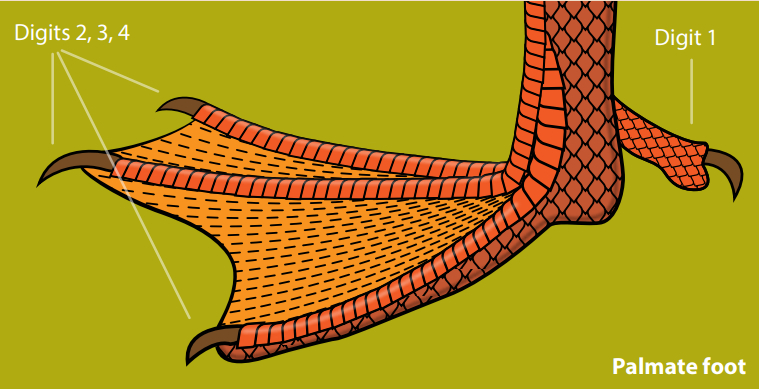Waterfowl: The original flying boats

You might be familiar with the Hans Christian Andersen tale of the Ugly Duckling (Den grimme ælling in the original Danish). It tells of a nest of duck eggs that hatch on a farm, with one hatchling appearing somewhat different to the others. Noticing this, the other birds and animals subject the hatchling to much verbal and physical abuse, deeming it as ‘ugly’.
The Ugly Duckling, along with its nest companions, belongs to the family Anatidae, which includes ducks, geese, and swans. Anatidae contains over 160 living species of waterfowl (a term which in the US means all varieties of ducks, geese, and swans) spread across multiple genera. The smallest of these is the cotton pygmy goose (which is actually a duck) at approximately 27 cm (11 in) long and 160 g (6 oz), while the largest is the trumpeter swan, as much as 180 cm (6 ft) long and 17 kg (37 lb).1
Waterfowl are mostly herbivorous, though the diet of some species includes fish, molluscs, and aquatic arthropods. They are found on every continent except Antarctica. As for the Ugly Duckling, we’ll return to that tale at the end.
Waterproof wonders

There is a saying that if you are naturally good at something you take to it ‘like a duck takes to water’. And waterfowl were certainly created to take to water. They are very buoyant and can sometimes be seen sleeping while floating on the water’s surface. The hollow bone structure most birds possess, along with the ability to trap pockets of air in the layers of their feathers, play a significant role in such buoyancy.
When a waterfowl needs to submerge (for example, when a duck dives below the water to feed) it can squeeze out the required amount of air from those feather spaces to accomplish this. When waterfowl emerge from the water, the hydrophobic (water-repelling) nature of their feathery coats allows them to simply shake themselves dry—without the feathers ever having become saturated. Hence another common saying, that when someone can readily dismiss something without it affecting them, it rolls off them easily, ‘like water off a duck’s back’ (fig. 1).

Several factors contribute to this ability. Not only do waterfowl have a greater density of the outermost feather layer (contour feathers) than their terrestrial counterparts, the density of the barbules in each feather (fig. 2) is also greater.2,3 This results in a barrier that is both wind- and water-resistant, with the layers of feathers acting like a maze, making the path that water must navigate to reach the skin increasingly convoluted. Additionally, each layer of feathers increases the hydrostatic pressure required for the water to force its way inwards.4
However, to be fully waterproof, waterfowl preen their feathers with oil from their uropygial (preen) gland, located on their rumps above their tail-feathers. While all birds have this gland, waterfowl have much larger, more developed glands.2 Preening also allows waterfowl to ensure their feathers remain flexible, strong, ready for flight, and free of parasites. This is such an important component for waterproofing that some species can spend up to 25% of their waking hours preening.2
Inspired by God’s handiwork
As often noted in Creation, mankind is increasingly being inspired to copy and use various design functionalities observed in nature, giving rise to the expanding field of biomimetics. The brilliant features of waterfowl are no exception. Researchers at Virginia Tech5 have spent the past decade studying the structure and performance of duck feathers to learn how the birds are able to transition so easily between underwater and surface environments.
The result is what can be termed a synthetic feather. The researchers hope it can one day be applied to the hulls of ships, potentially reducing drag, discouraging barnacle growth, and increasing fuel efficiency.4 But the speed of a ship is far greater than that of a water bird, so the resistive force experienced is also greater. The team must therefore now find a way for the synthetic feathers to compensate for that.4 And while human designers diligently try to mimic such marvels, for the One who created them in the first place, it’s as easy as the way water rolls off a duck’s back.
Propulsion and rudders
When walking on land, waterfowl often do so with an awkward, waddling gait, though when needed they can move quite quickly. However, once in water their webbed feet provide an excellent and efficient means of locomotion. The legs are set back in the torso allowing the feet to paddle from the rear, pushing rather than pulling the bird. When drawing the leg forward, the toes move inwards towards each other to create minimal resistance. On the backward stroke, the toes splay outwards. This allows the webbing to have maximum effect, driving the bird forward with greater force.
Webbed feet are also used to great effect when landing on water. It is a truly marvellous sight to observe waterfowl approach a body of water, webbed feet splayed wide. This creates the largest possible surface area for planing across the water and so slowing themselves down (see fig. 3 and ‘Webbed feet’).

Fast and furious flappers
Nearly half of all waterfowl species are completely or partially migratory.6 The vast majority of the remainder wander over a wide area in response to changing water levels and available food sources. With the exception of a few species, waterfowl are strong flyers, having powerful pectoral muscles used in the continuous beating of their narrow-pointed wings. These are put to good use, with some geese able to fly as high as 10,000 m (33,000 ft)6 and cover up to 2,400 km (1,500 miles) in a 24-hour period with favourable conditions.7
Such continuous use of their wings when flying expends a lot of energy, so waterfowl fly in V formation. This allows the outside birds to take advantage of the upwash created by the wingtip vortices of the inward lead birds. It is estimated this saves 10–14% energy, so the birds can travel farther for the same energy expenditure (fig. 4).8 God is glorified when we consider the genetic information given to waterfowl involving complex mathematics to determine such appropriate positioning in flight.

Evolution, or variation within kind?
Anseriformes is the order that includes Anatidae, by far the biggest family within it. The earliest fossils regarded as anseriform are two bones recovered from the Hornerstown Formation of New Jersey, assigned to Anatalavis rex.9 These are from rocks assigned to Late Cretaceous or Paleogene in the evolutionary scheme, supposedly 80–50 Ma.6
The first known duck fossils are in rocks said to be from 34 Ma, while the ‘earliest’ rocks with fossils readily assigned to genus Cygnus (swan) are Miocene (allegedly 23–5 Ma). The obvious error with such thinking is that the fossil record does not indicate an order of appearance over vast ages, but the order of burial during the catastrophic Flood of Noah.
Crucially, we don’t find a series of transitional fossils depicting a step-by-step progression of prior creatures transforming into waterfowl. Instead, we see representatives of the original created kind exhibiting some of the tremendous variety that was already present in waterfowl DNA in Creation Week. Though some diversification may have taken place pre-Flood, likely much more would have taken place thereafter through natural selection/speciation.
These daughter populations of the original created kind together exhibit more variety than in the initial representatives of their kind that came off the Ark. But each has less variability, i.e. potential to vary. This is the opposite of the hypothetical evolutionary process, which needs an increase in new functionality not previously present.10 Think of the way in which domestic dog breeds have arisen through (artificial) selection. All are still able to interbreed, not only with each other, but often even with the wolves from which the earliest domesticated dogs arose. And wolves can still interbreed with other members of their kind, e.g. coyotes and poodles.
Postscript

Returning to our friend the Ugly Duckling; he belonged to the genus Cygnus, ultimately growing into a beautiful swan (fig. 5) and finding friendship and family among those just like him. Yet the ducks he started life with didn’t realize that regardless of superficial appearances, they were all part of the same ‘family’—one created kind, descended from the same ancestors (see box).
Similarly, people can suffer at the hands of others for no other reason than that they come from a group that looks superficially different to that of their tormenters. Those who do this fail to recognize that we are all one people, one blood, one family—all equally descended from Adam and Eve, one created kind.11
Applying the analogy in another context, Christians are often considered the ugly ducklings in a secular world and subject to at least verbal abuse for our witness for Christ. Those around us often don’t understand what makes us different, and how they too can become part of another family, God’s. But just like the hapless duckling, what ultimately awaits us is a beautiful transformation, in this case into the likeness of Christ: the perishable to become the imperishable, the natural body raised as a spiritual body (1 Corinthians 15:42–44).
Webbed feet


There are several varieties of webbed feet in aquatic birds. The one shared by waterfowl and several other kinds of bird is known as palmate. The webbing is between the front digits 2, 3, and 4, with the hind-facing digit 1 separate (inset, right). Some mammals also have webbed feet, such as the platypus, beaver, and otter. Since these are not closely related to each other in evolutionary belief, evolutionists cannot use the similarities as evidence they descended from the same ancestor. Instead, such shared design features are explained as examples of ‘convergent evolution’. I.e. they arose randomly multiple times across different vertebrate taxa over millions of years, coming up with the same design. It makes more sense to regard these examples as a common design feature used by the Designer of all life. However, that may not always be so; in some animals, webbing between the feet may have arisen from a mutational loss of the normal apoptosis (programmed cell death) in the embryonic plate that results in separate digits.12 For instance, polar bears and grizzlies can interbreed, but the former have partially webbed feet, something which was not likely in the original bear ancestor of both.13
Ducks, geese, and swans—all one kind
Hybridization is a commonly used criterion to determine if two groups, A and B, belong to the same kind or not. The ability to interbreed with viable offspring indicates they are the same kind. If A and B cannot hybridize, however, that does not necessarily mean they are a different kind, as many reproductive barriers may have arisen from mutation since creation. But if A and B can each interbreed with a third group, C, then A, B, and C must logically all be the same kind. Ducks and swans cannot interbreed. But ducks can interbreed with geese. And swans can interbreed with geese, too (a swan-goose hybrid, like the baby shown here with its swan parent, is called a swoose). So by this criterion, all three are descended from one created kind. This likely extends to all members of the anatid family, though it doesn’t preclude the kind possibly being at the level of the anseriform order (a larger grouping).
There are several important differences between waterfowl species. Some duck species have iridescent feathers (fig. 1) that geese and swans don’t have. This may be a feature that has been lost to other members of the waterfowl kind. Perhaps it is information encoded in all waterfowl DNA but only activated in certain species. Additionally, ducks have only 16 vertebrae, while geese have 18 or 19 and swans 24 or 25. However, this does not speak strongly against their being the same kind, even without invoking mutational loss or duplication; creationist baraminology researcher Jean Lightner points out14 that in mammals, such skeletal variation even within the same species is common. Even domestic pigs can vary in the number of their thoracic and lumbar vertebrae, and the genetics of this are being elucidated.15
References and notes
- See en.wikipedia.org/wiki/Anatidae accessed 28 Oct 2021. Return to text.
- Cassidy, J. and Roth, A., What actually makes water roll off a duck’s back? kged.org, 18 Aug 2020. Return to text.
- Bergman J., The evolution of feathers: A major problem for Darwinism, J. Creation 17(1):33–41; creation.com/feather for greater detail on feather design, Apr 2003. Return to text.
- Stimpson, A., Duck feathers are the next revolution for the world’s biggest ships, popularmechanics.com, 30 Aug 2021. Return to text.
- Virginia Polytechnic Institute and State University, Blacksburg, VA, USA. Return to text.
- Ducks, geese, and swans: Anatidae, encyclopedia.com. Return to text.
- Handwerk, B., Do Canada geese still fly south for winter? Yes, but it’s complicated, nationalgeographic.com, 17 Dec 2020. Return to text.
- University of Oxford, One good turn: Birds swap energy-sapping lead role when flying in v-formation, sciencedaily.com, 2 Feb 2015. Return to text.
- Vegavis iaai (69–66 Ma) might be an ‘older’ anserifom; Clarke, J. and 9 others, Fossil evidence of the avian vocal organ from the Mesozoic, Nature 538:502–505, 2016. Return to text.
- Wieland, C., The evolution train’s a-comin’; creation.com/train. Return to text.
- Wieland, C., One Human Family, Creation Book Publishers, Powder Springs, GA 2011; creation.com/s/35-4-521. Return to text.
- Statham, D., Homology made simple, see fig. 4 in creation.com/homology-simple. Return to text.
- Weston, P. and Wieland, C., Bears across the world; creation.com/bears. Return to text.
- Lightner, J., Samotherium fossils and variation in the neck within the giraffe kind (Giraffidae), J. Creation 30(2):6–7, 2016. Return to text.
- Rohrer, G.A. et al., A study of vertebra number in pigs confirms the association of vertnin and reveals additional QTL, BMC Genetics 16:129, 2015. Return to text.






Readers’ comments
Comments are automatically closed 14 days after publication.